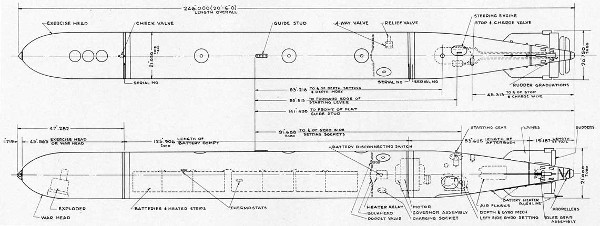![]() The Pacific War Online Encyclopedia
The Pacific War Online Encyclopedia
|
| Previous: U.S. Mark 15 Torpedo | Table of Contents | Next: U.S. Mark 24 Torpedo |

| Dimensions
|
21" by 20'5" 53.3cm by 6.223m |
| Weight |
3154 lbs 1431 kg |
| Range | 4000 yards (3650m) at 29 knots |
| Warhead | 575 lbs Torpex 261 kg Torpex |
| Propulsion | Electric |
| Production |
About 8500 |
The Mark 18 was an electric torpedo based on the German G7e, examples of which were captured by the British
in August 1941. The U.S. Navy had been experimenting with electric
torpedoes since 1915, but at a very leisurely pace until examples of the
G7e were provided to the Navy by their British counterparts. With the
Navy's Torpedo Station already working at full capacity to remedy the
shortage of wet-heater torpedoes, the project was turned over to
Westinghouse. A reluctant partner at first, Westinghouse was initially
instructed to make the closest possible copy of the G7e in order to put
the new torpedo into production as soon as possible. However, German
engineering and manufacturing techniques could not be economically
duplicated, and Westinghouse redesigned the torpedo to use a new
thin-plate battery produced by Exide and to use the same control
mechanisms used in other American torpedoes. The initial design had
numerous bugs and the first production Mark 18s did not reach the fleet
until September 1943.
A significant design challenge was designing an electric motor both
compact enough to fit in the torpedo case and powerful enough to produce
an acceptable speed. Westinghouse solved the problem by relaxing the
usual quality controls on an electric motor, and the Mark 18 motor was
prone to both overheating and sparking commutators. Since the motor only
had to last long enough for the run to the target, this was considered
acceptable, as was the corollary that the motors would have to be
refurbished after each practice run.
Like other electric torpedoes, the Mark 18 left no
wake and was easier to construct than a wet-heater torpedo. It became
very popular with submarine
commanders convinced that its lack of wake gave a significant tactical
advantage. Postwar studies failed to bear this out, finding that
conventional wet-heater torpedoes were 17% more likely to hit a
merchantman and 250% more likely to hit an escort. The overall hit percentage for the Mark 18 was 28%. It was a noisy
torpedo posing a significant risk of a hydrogen explosion, and a hydrogen fire on Flying Fish heated a Mark 18 to the point where the Torpex melted and ran out of the warhead. As a result, the Mark 18 it was retired from service in 1950.
References
The Pacific War Online Encyclopedia © 2014 by Kent G. Budge. Index